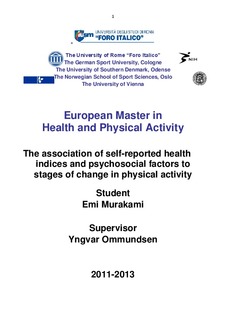| dc.description.abstract | Background: Low levels of physical activity are a major risk factor for lifestyle diseases and
mortality from all causes. Despite the well-known health benefits gained from physical
activity, population levels of participation are insufficient low. Improved knowledge about the
psychosocial factors might be helpful in understanding why some are active and others not.
Purpose: The purpose of this thesis is to 1) examine the association of self-reported health
indices and psychosocial factors to stages of change in physical activity. 2) To examine the
moderating effects of gender, age groups and educational background in the association of
self-reported health indices and psychosocial factors to stages of change in physical activity .
Method: This is a cross-sectional study based on data from the “Romsås in Motion” project.
Altogether, 2336 men and women aged 31-67 years completed two self-administered
questionnaires that assessed different socio-demographic variables, indices of health, BMI,
stages of change in physical activity, and selected theoretically informed psychosocial
variables supposed to influence stage of change in physical activity. The statistical tests
comprised descriptive statistics and multiple regression analyses. Results: Analyses revealed
that the psychosocial variables explained 42% of the variance in the stages of change score,
whereas the variables comprising health indices while controlling for BMI and sociodemographic
variables (age, gender and education) only accounted for 8%. Social support
from family and friends for being physically active, identification as being a physically active
person and self-efficacy in face of psychological barriers represented strong psychosocial
influences to stages of change. Further, self-efficacy in face of practical barriers and social
support accounted for more variance among men than for women, and older adults seemed to
rely less on social support, and higher educated participants were more confident that they
could overcome practical barriers and were less dependent on support from family.
Conclusion: The findings suggest that intervention aiming to activate sedentary adults and to
help active adults remain at their activity level may be more successful if they foster support
from family and friends and increase their confidence in overcoming psychological barriers.
While the results regarding social support seems to vary a bit between socio-demographic
subgroups, the finding concerning self-efficacy for psychological barriers seems to apply
across subgroups. Results for the psychosocial influences also seem to apply, irrespective of
variations in self-reports of psychological health and general self-perceptions of health as well
as BMI score. | no_NO |
